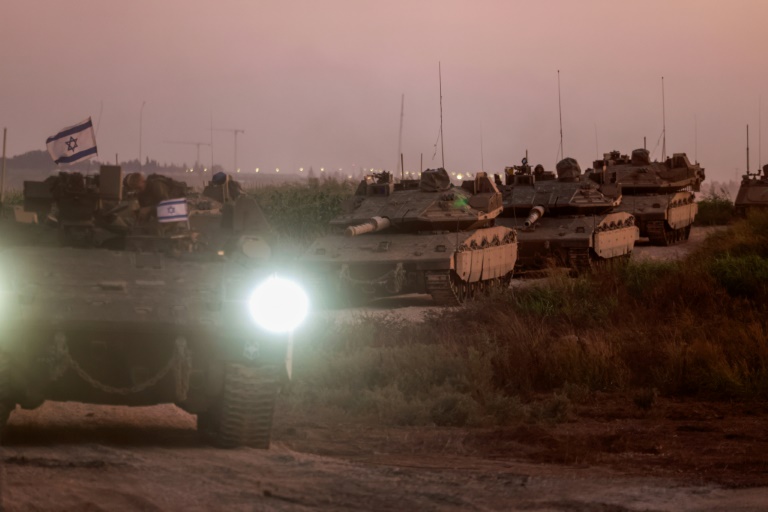In Gaza, a desperate search for loved ones under the rubble

Israel’s military has mobilised troops and heavy weaponry at the border, and could launch a ground offensive
Gaza City – Rescuers lifted a cement block and pulled the lifeless body of a Palestinian from the rubble of a residential building destroyed by Israeli air strikes on the besieged Gaza Strip.
“Why? We did nothing, oh God,” screamed a weeping young man as his relative was wrapped in a shroud and carried away on a stretcher as fighting triggered by Hamas’s deadly attack on Israel raged for a sixth day.
The Hamas-ruled enclave has been under heavy bombardment since Saturday when the group’s fighters crossed into Israel and killed more then 1,200 civilians, soldiers and foreigners.
Retaliatory Israeli shelling and air strikes on Gaza have killed more than 1,300 people, most of them civilians, according to Palestinian health officials.
On the opposite side of Shati, Gaza’s largest refugee camp, another cry let out: “Come! He’s still alive.”
Rescuers rushed to remove the debris around a hand rising from the rubble, eventually managing to free the trapped man.
With blood dripping down his head, he was taken by the volunteers to nearby ambulances who had come to retrieve Palestinians — dead or alive — caught in the crossfire.
– Destruction –
The Gaza Strip, which has endured multiple brutal wars with Israel, is under “total siege” after Israel cut off access to water, electricity and fuel.
Day and night, there has been no let up in the thundering of explosions and buzzing of drones in the densely populated enclave, which is home to 2.4 million people — half of them children.
Militants in Gaza have kept up their rocket attacks into Israel, which has massed tens of thousands of troops along the border in what appears to be a preparation for a ground invasion.
Israeli Prime Minister Benjamin Netanyahu on Thursday vowed to “crush” Hamas in response to what has been declared the deadliest day in Israel’s 75-year history.
AFP journalists witnessed Israeli warplanes carrying out dozens of strikes on Shati, the crowded refugee camp, within the span of half an hour on Thursday morning.
A four-year-old child cried as his father scrambled to pull him from under the rubble.
“Daddy, where is my mom and my siblings?” the boy screamed, covered in dust and bleeding from multiple wounds on his tiny body.
Jamal al-Masri, owner of one of the destroyed homes, said the attack took his family by surprise.
“We were asleep. Suddenly, the entire neighbourhood came under the occupier’s bombs. My house, my brother’s house, my family’s house, and several neighbours’ houses were completely destroyed,” he told AFP.
When he emerged from his home, Masri said he was met with a scene of carnage.
“I found everyone dead, body parts and bodies of my sons and their children,” he said, his eyes wide open in shock.
He tried to soothe his daughter who was yelling “what happened, Dad?” Is this really happening to us?” in disbelief.
“It will be okay,” he replied, “we will stay, we will not leave Gaza” — even though around him, nothing was left.
In many neighbourhoods — those that have not been reduced to a pile of smoking ruins — there is no longer electricity.
The sole power plant supplying the territory has stopped working after running out of fuel due to the siege. And with it, internet, water and even telephone communications have largely gone.
The United Nations has criticised Israel’s siege as a possible violation of international law.
– Chaos –
At al-Shifa Hospital, the largest in the enclave which has been under a strict Israeli blockade for 16 years, there was chaos.
Amid the uninterrupted stream of ambulances, relatives asking for news, injured arriving and leaving, two children sat on the ground, stunned and silent.
A nurse handed one of them over to a doctor, who called out, “does anyone here know this child?” before rushing to the dozens of wounded sprawled on thin mattresses.
Behind him, wails of pain escaped the mortuary from relatives of the dead.
Inside, dozens of bodies wrapped in white shrouds fill the cold storage units and cover the floor.
One young man staggered out. “Maybe he’s not dead. His body isn’t here,” he shouted.
“Let’s check the emergency room. He’s probably undergoing surgery,” he repeated, as if to convince himself.
